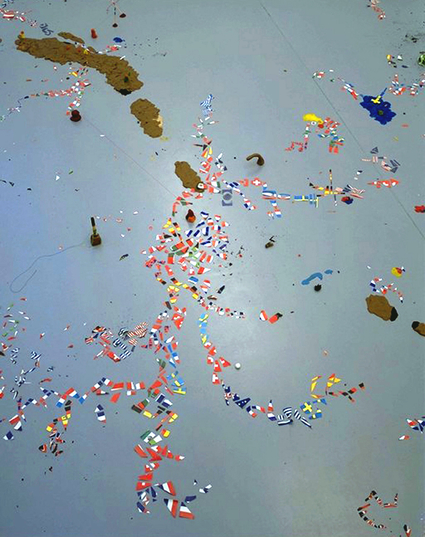When I create a work, I first follow the nature, structure, quality and the meaning of materials and objects that I am dealing with. For instance, I believe that the emotional meaning of cigarette butts lies in the fact that they are a remnant of human behaviour and desire. Ashes imply that something was burnt. They represent the process of disappearance and death. In the end, I use this emotional meaning and the organic structure of objects to give form to my work.
One day, I put a big glass tube (about 30cm x 150cm) on the floor in the corridor of the Art Academy. A man with limited eyesight knocked over the tube and smashed it completely. I went there and knew I had discovered something important, yet it was not clear to me what that something was. How the tube turned into pieces of glasses in one second was amazing. The tube was no longer there: only fragments remained. I then realized that in nature, everything changes, and that nothing is stable. When something disappears or is destroyed, something new begins. This discovery gave me an idea of destroying objects and making something new out of them, as if creating a new landscape with pre-existing materials.
In my work, the old and the new, and the end and the beginning are present at the same time. In other words, different concepts of time claim the same space. The works show and imply the direct and natural process of material changing. For example, when the heat of the tea inside the cylinders melts the wax and clay, it leaks onto the floor spilling their contents. Another example is in a recent work public can recognize the different states of growth of the beans in the same space.
The development of individualism has been very important in modern Europe. The strong sense of ‘individual’ in Europe seems to come from the conviction that human being is at the centre of the world. As a consequence, the past is ordered in a chronological way according to individual experience. In Japan, we tend to grasp history as a whole. For example, we are satisfied with the family tree, and do not try to remember each single name. In Europe, people develop by pursuing their personal desire, and by following a sense of responsibility and judgement. Having established their ego, people tend to relate differently to others. This is the reason why, in Europe, it is possible to objectify one’s feelings by transforming them into symbolic forms. In Japan, we tend to acquire a sense of coexistence. Consequently, we have a tendency to make connections with things around us rather than clearly objectifying them. For example, HAIKU is a unification of the state of nature and one’s feelings, not a simple expression of one’s emotions. This unification is expressed by a subtle connection between words.
In my work, I consider it important to have not only an emphasis on aggression, but also on conflicting aspects of things, such as order and disorder, life and death, violence and peace, beauty and ugliness, and humour and seriousness. Therefore, I could not totally agree with some public opinions which associated my work with Hiroshima and the War. I did not intend to create a work which would express war. However, if one goes deep into a well, one can find water, which connects to another water source. As one descends deeper into sub- and un- consciousness, one reaches a level that is undifferentiated from the unconsciousness of others. While I am working, I sometimes enter a state in which I am not sure if I am the one who is creating the work or the work is leading me. According to Freud, there is a division between consciousness and unconsciousness. However, in Buddhism, there is a different level of consciousness. Lowering the level of consciousness (think, for example, of meditation) does not mean that one loses the ability to judge, or to observe and to concentrate. In this sense, my work experiences at a hospital as a midwife and a nurse, and the fact that I moved to live in Europe, that I have a childhood memory of my father as a Kamikaze pilot, and that I grew up in post-war Japan, would all be represented unconsciously in my work. It would be no surprise if some part of my work stimulates and evokes other people’s deep memory.
Since 2001 I have been developing a project about my father who served as a kamikaze and survived. That is my first conscious project to find out how my personal experience actualizes as an artwork. I finally would like to publish a book. It gave me many opportunities to use the other methods (drawing, making a collage, photographing, making a video and writing text) to work out the concept, which relates to the past and present, and human grief. It required in me a development for the sensibility to examine images, and it was necessary to use the images themselves, not to transform them, but go beyond. I needed the text and other ways, like drawing and overlapping, to reach what I wanted. The drawing can be a way of transforming, but I tried to get the essence from the photos and draw them. In the process I started thinking a lot about the work of Pablo Picasso and Jean-Luc Godard. Especially the overlapping images of Jean-Luc Godard in many ways influenced the images I made for the book.
5 April 2008, Keiko Sato





